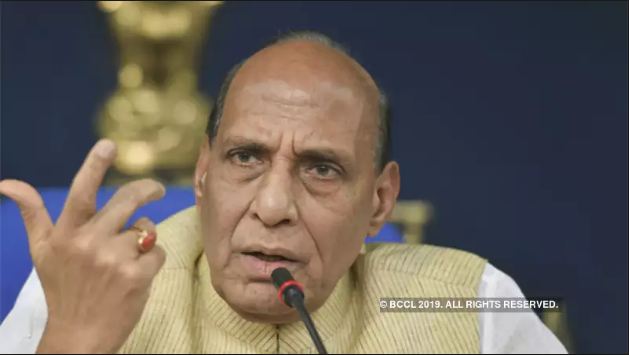A bold tweet by union Defence Minister Rajnath Singh has taken Twitter by storm as he pointed out the thought process behind the naming of weaponry by India as opposed to its rogue neighbor Pakistan. He tweeted, “India has produced Missiles with names like Prithvi, Akash, Agni, Trishul and Brahmos which invoke ‘Samyam, Santulan and Sanhar if needed’. Whereas our neighbour names her Missiles after invaders like Babur, Ghori and Ghazanavi which indicates her intention.”
India has produced Missiles with names like Prithvi, Akash, Agni, Trishul and Brahmos which invoke ‘Samyam, Santulan and Sanhar if needed’. Whereas our neighbour names her Missiles after invaders like Babur, Ghori and Ghazanavi which indicates her intention.
— Rajnath Singh (मोदी का परिवार) (@rajnathsingh) August 3, 2019
Nonetheless, this tweet surely generates curiosity around the nomenclature of India’s defence equipment. While Pakistan names its weaponry after cruel and barbaric Islamic invaders, India opts for names with philosophical meanings. The star in India’s missile inventory is undisputedly the Agni series ballistic missiles with Agni I ( medium-range ballistic missile ) with a range of or around 900 km to the under development Agni VI (intercontinental ballistic missile) with a staggering 10,000 km range. One of Agni’s epithets is Abhimāni (from Sanskrit: abhi (towards) + man (the verbal root man ‘to think’, ‘reflect upon’) meaning dignified, proud; longing for, thinking. Agni is a symbol of piety and purity. As expression of two kinds of energy i.e. light and heat, he is the symbol of life and activity.
Another one of the most critical missiles in India’s inventory are the Akash series missiles. Akash is a medium-range mobile surface-to-air missile defense system developed by the Defence Research and Development Organisation (DRDO) .The highly advanced system is capable of targeting any air borne target upto 30 km away, at altitudes up to 18,000 meters. Akash is one of the Panchamahabhuta, or “five gross elements” according to Indic knowledge systems with a literal meaning to be ‘visible,’ ‘sky,’ ‘atmosphere’ or ‘open space.’
Trishul (Trident) is another short range surface-to-air missile developed by the Defence Research and Development Organisation (DRDO). Trishul or trident symbolizes various trinities of balance. It also represents ‘sanhaar’ which essentially paves way for new live. Some commonly represented trinities are creation, maintenance, and destruction; past, present, and future; body, mind and atman; logic, passion and faith; creation, order and destruction; the three gunas: satva, rajas and tamas.
BrahMos is named after the river Brahmaputra and the Russian river Moskva. Other names like Arjuna, Prithvi and many more of the Indian defence forces carry with them deep philosophical meanings and certainly not names of invaders and marauders. On the other hand, Pakistan chooses to name their weapons on barbaric invaders who have not only destroyed culture of what is now Pakistan and India but also tortured, murdered and forcefully converted millions of Hindus. Some of the names used by Pakistan for their missile inventory include Babur, Ghaznavi and Ghori.
Pakistan glorifies and celebrates these invaders. Giving an insight into the dark and inhuman period for people living in the Indian sub-continent Dr. Koenraad Elst in his articles “Was There an Islamic Genocide of Hindus?” writes:
“There is no official estimate of the total death toll of Hindus (everyone living in the Indian Subcontinent was denoted by –Hindus) at the hands of Islam. A first glance at important testimonies by Muslim chroniclers suggests that, over 13 centuries and a territory as vast as the Subcontinent, Muslim Holy Warriors easily killed more Hindus than the 6 million of the Holocaust. Ferishtha lists several occasions when the Bahmani sultans in central India (1347-1528) killed a 100,000 Hindus, which they set as a minimum goal whenever they felt like punishing the Hindus; and they were only a third-rank provincial dynasty.”
Along with the cold-blooded murder of crores of Hindus these barbaric invasions also witnessed complete contempt for Indian Temples and traditions, Somnath temple in Gujarat, Kashi Vishwanath Temple in Varanasi, Krishna Janmbhoomi Temple in Mathura, Nalanda in Bihar, Sun temple in Martand are just a drop in the ocean of the many Hindu Dharmic cultural centers which were destroyed by Islamic invaders that Pakistan celebrates today. However, after failing to overshadow the intrinsic liberal and brave domains of Dharmic traditions, Islamic Invaders were clearly losing grounds to resurging Hindu forces. Towards the 1700s the rise of several Hindu kings like Chattrapati Shivaji and others were successful in putting an end to the centuries’ old tyranny of Islamic invaders. Nonetheless, Pakistan not only glorifies these rapists, murderers and marauders but also uses this provocative nomenclature for their military-terrorism complex which not only shows their blatant contempt for Hindu culture but also entails the undercurrent of their sinister intent towards India and its people.


































